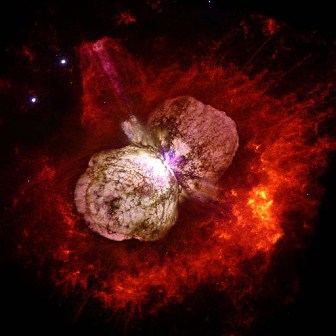Space Saturday XI
Sky and Telescope had an article about this, so I figure I could be a follower. For this week’s Space Saturday, I bring you Eta (η) Carinae.

Source: HST / Nathan Smith / Jon Morse / NASA
Eta Carinae is a star in the southern hemisphere about 10,000 light years distance in the constellation Carina:
Eta Carinae is one of the most massive stars in the universe, with probably more than 100 solar masses. It is about 4 million times brighter than our local star, making it also one of the most luminous stars known. Eta Carinae radiates 99 % of its luminosity in the infrared part of the spectrum, where it is the brightest object in the sky at 10-20 microns wavelength. [source]
Some have even estimated that Eta Carinae could be upwards of 150 solar masses. The star is surrounded by the aptly named Eta Carinae Nubula (NGC 3372). The two lobes of gasses were formed after an explosion that the earth “viewed” in 1843. Because the star is so massive it expends it fuel very rapidly (which makes it very luminous - Eta Carinae emits more light in 6 seconds than the sun does all year!), astronomers think that it will go supernova and ends its life (of approximately 1 million years, as opposed to a sun type star’s 10,000 million year typical life) in the next few 100,000 years. Another distinctive feature of Eta Carinae is its long term veriation of visual magnitude (see resource links for additional information).
Sky and Telescope recently published an article that suggests Eta Carinae Has a Neighbor.
Iping and her colleagues base their conclusion on spectra taken by NASA’s Far Ultraviolet Spectroscopic Explorer (FUSE) satellite. The team noticed that in June 2003, Eta Carinae’s far-ultraviolet flux suddenly disappeared, presumably because the companion star had swung behind the primary and was eclipsed by its thick wind. The timing of the disappearance coincided perfectly with the predictions of the binary model.
Of course there is always disagreement, but that is one thing that makes astronomy interesting.
Resources
Wikipedia - Eta Carinae
SEDS - Eta Carinae
SEDS - Super Sharp HST View of Eta Carinae
Hubblesite - Doomed Star Eta Carinae
Sky and Telescope - New Signs that Monster Star Has a Neighbor
My Space Saturday Archive - my (somewhat) weekly astronomy picture archive.
-Matt Jones
Ή χάρις του κυρίου ημων Ίησου Χριστου μεθ’ υμων.




Recent Comments